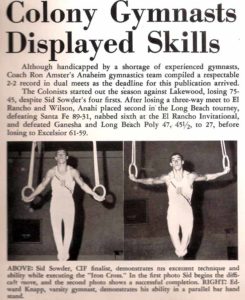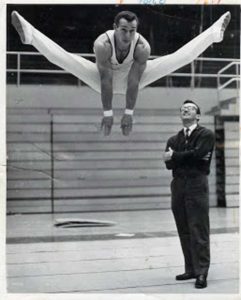 It was a long walk f0r a boy from Anaheim, who used to dive off the garage rafters on to an old couch, to carrying the flag in the ’68 Olympics as co-captain of the Men’s Gymnastics Team in Mexico City.
It was a long walk f0r a boy from Anaheim, who used to dive off the garage rafters on to an old couch, to carrying the flag in the ’68 Olympics as co-captain of the Men’s Gymnastics Team in Mexico City.
But Class of 1963’s Sid Sowder Freudenstein’s transition to a world champion, from that 6th grader whose grandfather found him alone doing dangerous diving stunts, started when he was enrolled him in Sammy Lee’s swim & dive club.
It was in junior high where he discovered some bars and rings outside in a sandpit and he taught himself kips and giant swings (with straps). “I didn’t know the names of the skills then; I just saw other kids doing them,” he wrote in his autobiography.
 Freudenstein started formal gymnastics as a sophomore in 1960 under Ron Amster at Anaheim High. He credits his coach as being responsible for his initial success. He won many competitions, mostly on tumbling, floor and vault. In his senior year, he was the High Point Man (closest to All-Around) at the Southern California State Championships.
Freudenstein started formal gymnastics as a sophomore in 1960 under Ron Amster at Anaheim High. He credits his coach as being responsible for his initial success. He won many competitions, mostly on tumbling, floor and vault. In his senior year, he was the High Point Man (closest to All-Around) at the Southern California State Championships.
He wasn’t able to attend his first choice, UC Berkeley (Cal), because his grades weren’t quite good enough. He was awarded a scholarship to USC and was excited to attend there since many of his friends were also at USC. Unfortunately, when went to matriculate, he was told his scholarship went to someone else.
He was devastated, but kept up his studies at Santa Ana Junior College and continued to train at Anaheim High. He finally made it to Cal in 1964 and graduated in 1968 with a degree in physics. As a UC Berkeley student, Freudenstein won many invitationals, PAC 8, regional titles, and national and international awards.
In the summer of 1966, he was chosen to attend an Olympic training camp at Penn State, and most importantly, as a U.S. Gymnastics Federation alternate to the World Championships in Dortmund Germany.
In the summer of 1967, he was chosen to compete in the World University Games in Tokyo. He placed second in floor exercise against some of the best in the world.
 In his senior year in 1968, at the NCAA Championships he tied for first on floor exercise, and his team won the title in a thrilling ending.
In his senior year in 1968, at the NCAA Championships he tied for first on floor exercise, and his team won the title in a thrilling ending.
He was on the way to the Olympics after placing 19th out of 20 selected in first trials. While he did well in the 1968 games, he was sick for several training days and the compulsory floor finals were held first thing in the morning when scoring was generally low.
Freudenstein continued to stay involved in his sport, even after returning to school at the University of Colorado (CU), earning a Ph.D. in physics in 1976-77. He occasionally judged high school gymnastics meets, announced CU’s home meets, and took the job of head gymnastics couch a year before he started to teach physics at Metropolitan State College of Denver in the spring of 1977.
He taught and coached until CU dropped seven sports, including gymnastics in 1980. During his coaching tenure at CU, he brought the team from shambles to a top-10 preseason ranking.
In 1980 and 1982, he was chosen by the State of Colorado to be the exchange coach of a sister-state program in Brazil. In 1982, he started and directed a not-for-profit private club called Colorado Academy of Artistic Gymnastics (CAAG). It grew to its maximum of 417 students right after the ’84 Olympics.
Freudenstein has published and given talks on the biomechanics of gymnastics and authored a teaching manual for major textbook in physics. He has also published several papers in plasma physics and teacher education. He has chaired Denver’s Metropolitan State University Physics Department since 1995. In 2005, he was inducted into the University of California Athletic Hall of Fame.
For a more complete look at his Olympic career, visit:
http://www.sports-reference.com/olympics/athletes/fr/sid-freudenstein-1.html




